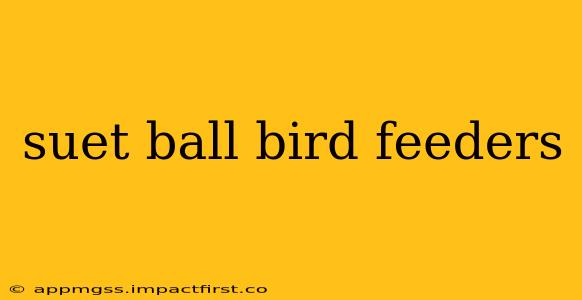Suet feeders are a fantastic way to attract a variety of birds to your backyard, offering a high-energy food source perfect for winter months and breeding seasons. Suet, a rendered beef fat, is packed with calories, providing birds with the fuel they need to survive harsh weather and raise their young. But not all suet feeders are created equal. This comprehensive guide will delve into the world of suet ball feeders, exploring their benefits, different types, and how to choose the right one for your feathered friends.
What are Suet Ball Bird Feeders?
Suet ball feeders are specifically designed to hold suet cakes or balls, a type of bird feed made from suet (rendered beef fat), seeds, nuts, and other ingredients. These feeders often feature a mesh cage or a similar structure that protects the suet from larger birds and squirrels while allowing smaller birds easy access. The design prevents the suet from melting too quickly in warmer temperatures and also keeps it relatively clean.
What are the Benefits of Using Suet Ball Feeders?
High-Energy Food Source: Suet provides a concentrated source of energy crucial for birds, particularly during cold weather or when raising young.
Attracts a Wide Variety of Birds: Different types of suet, with added ingredients like nuts, seeds, and dried insects, attract different species, making suet feeders a great way to diversify your backyard birdlife.
Easy to Use and Clean: Most suet feeders are easy to refill and clean, making them a convenient choice for bird enthusiasts.
Durable and Long-lasting: High-quality suet feeders can withstand the elements and last for many seasons.
What Types of Suet Ball Feeders are Available?
There's a surprising variety in suet ball feeder designs. Here are a few popular options:
-
Mesh Feeders: These are the most common type, featuring a wire mesh cage that holds the suet ball. The mesh allows birds to easily peck at the suet while protecting it from larger animals.
-
Suet Cake Feeders: These are designed to hold rectangular or square suet cakes, providing a more stable platform for feeding.
-
Log Feeders: These feeders mimic a natural log and often have multiple feeding holes or cavities, providing ample space for several birds to feed simultaneously.
What Kind of Suet Should I Use in My Suet Ball Feeder?
The type of suet you use will significantly influence which birds visit your feeder. Consider these options:
-
Plain Suet: A good base for attracting a range of birds.
-
Suet with Nuts: Attracts woodpeckers and other birds that enjoy nuts.
-
Suet with Seeds: Appeals to a broader range of seed-eating birds.
-
Suet with Insects: A great option for insect-eating birds like flycatchers.
Remember to choose suet that's free from harmful chemicals and additives.
How to Choose the Right Suet Ball Feeder for Your Needs?
Choosing the right suet feeder depends on several factors:
-
Your Budget: Prices range significantly; choose a feeder that fits your budget while still offering quality and durability.
-
The Birds in Your Area: Research the types of birds common in your region and choose a suet type they prefer.
-
Your Yard's Space: Consider the size and placement of the feeder in relation to trees and shrubs that can offer protection from predators.
-
Ease of Cleaning: Select a feeder that is easy to clean to prevent the spread of disease.
How Often Should I Refill My Suet Ball Feeder?
The frequency of refilling depends on the size of the suet ball, the number of birds visiting your feeder, and the weather conditions. Check your feeder daily and refill it as needed. In particularly cold weather, the suet may need refilling more often.
Can Squirrels Get into My Suet Ball Feeder?
Squirrels are notorious for their ability to access bird feeders! While a well-designed mesh feeder will deter many squirrels, some persistent ones can still find a way in. Consider adding squirrel baffles or choosing feeders with more robust cages to minimize unwanted visitors.
Where Should I Place My Suet Ball Feeder?
Ideally, place your suet feeder in a location that offers protection from the elements and predators. A location near trees or shrubs, but not directly against the trunk or branches, is usually ideal. Ensure the feeder is securely mounted and is accessible to birds but not easily reached by cats or other predators.
By understanding the different types of suet ball feeders and choosing the right one for your needs, you can create a thriving bird sanctuary in your own backyard, providing a vital food source for your feathered friends and enjoying hours of delightful birdwatching.
